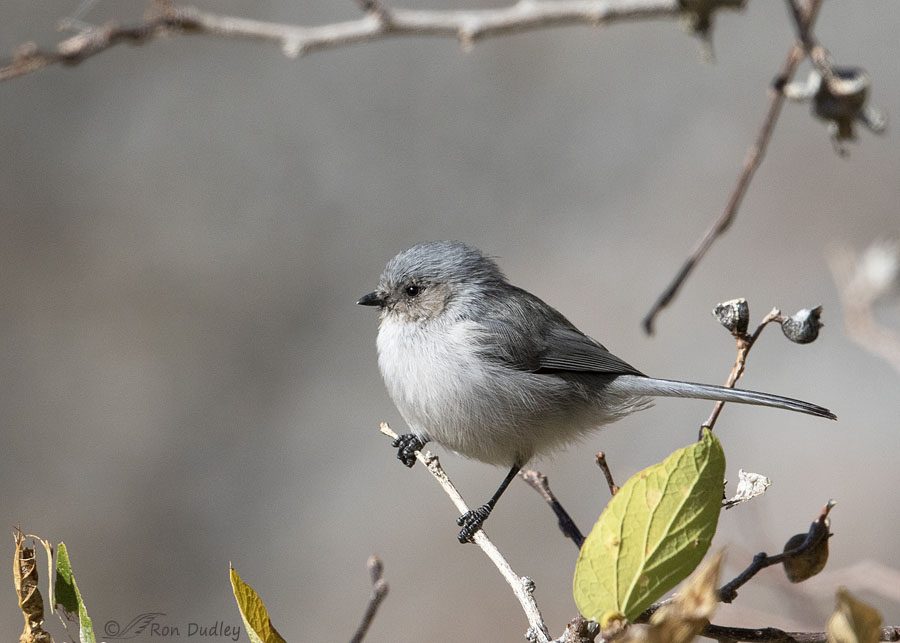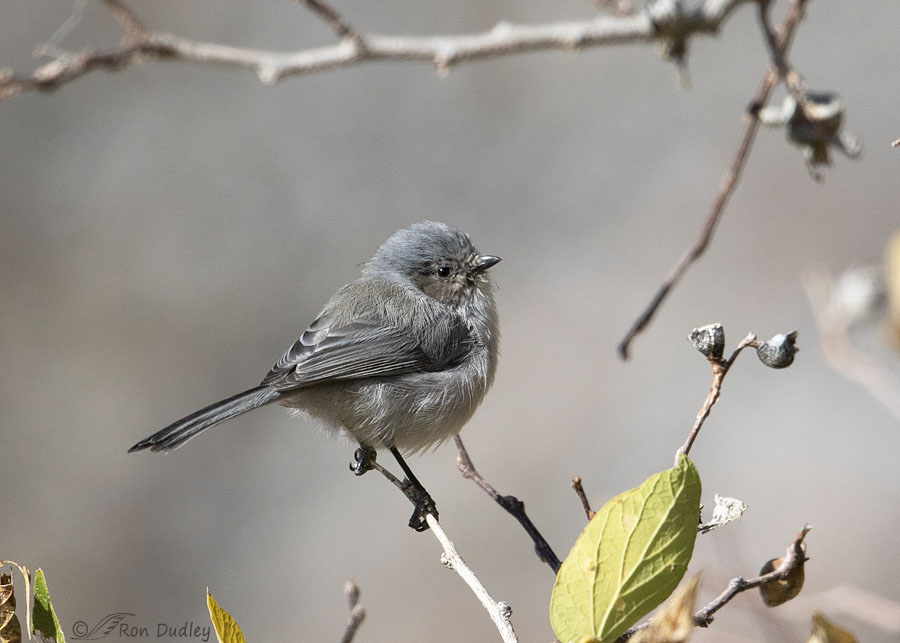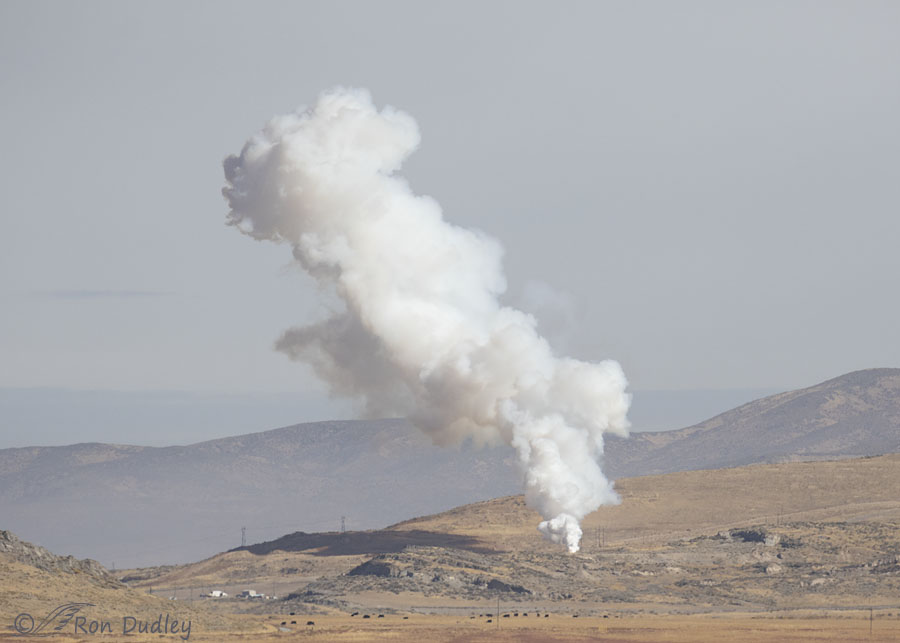And to think I used to think kinglets were hard.
I’ve never been able to get decent photos of Bushtits. I’ve seen them a few times but no photographic cigar. Early yesterday morning when it was still cold in remote Box Elder County I found a small bush with a few Bushtits scurrying around in the interior but they all flew off before I was able to get any photos.
So later in the morning after it warmed up I returned to the same bush on the theory that the tiny insects they feed on would be more active in the higher temperatures and the Bushtits would have returned to the bush to take advantage of the opportunity.
This time one of my ‘theories’ panned out.

1/5000, f/6.3, ISO 800, Canon 7D Mark II, Canon EF 500mm f/4L IS II USM + EF 1.4 III Extender, not baited, set up or called in
The small bush seemed to be dripping with Bushtits.
There must of been 20-30 of them flitting around in the interior of the bush and performing their chickadee-like acrobatics in their quest for tiny insects. They rarely, very rarely, came out in the open and when they did they typically stayed there for about a heartbeat before returning to the interior of the bush. I must have raised my lens on one of them over a hundred times only to have it dive back into the bush before I could get it in my viewfinder, much less in focus.
This male (dark eye versus light eye of the female) was one of my few successes and he even gave me a mostly clean background.

1/5000, f/6.3, ISO 800, Canon 7D Mark II, Canon EF 500mm f/4L IS II USM + EF 1.4 III Extender, not baited, set up or called in
He turned on his perch for a moment which gave me better light on most of his body and then he was gone.
Until yesterday I thought Ruby-crowned Kinglets were the flittiest, smallest and most difficult birds I ever (attempt to) photograph but that dubious distinction now belongs to Bushtits. By weight Bushtits are 19% smaller than Ruby-crowned Kinglets (5.3 grams vs 6.5 grams) and based on my experience with them yesterday they’re even more frenetic in their movements than kinglets. Even their species name “minimus” reflects their small size.
While I was attempting to photograph them I kept thinking “Wow, these guys are even more hyperactive than kinglets” and I even said it out loud at least once.
That’s something I thought I’d never say about any bird.
Ron
On an unrelated note:
On my way home yesterday I witnessed what was apparently an unannounced rocket test at Morton Thiokol’s Orbital ATK facility in remote Box Elder County.

This is what it looked like from what I’d estimate to be at least 7-8 miles away. Just before this photo was taken the fireball at the end of the rocket was so bright it was irritating to my eyes, even in full daylight.
It was indeed impressive.
In my reply to Melanie’s comment below I’ve included a link to a video of another rocket test at the same location. It’s definitely worth a looksee.


Sensational work Ron! Thanks for sharing!
Charlotte Norton
Nice captures. I did not realize that the eye color difference was sex-related. I never noticed this feature when I encountered and tried to photograph them when I lived in New Mexico. Indeed, the light never caught their eyes so my photos seemed so drab and lifeless despite their energetic behavior. That rocket shot is impressive. They burn a lot of fuel during the first few seconds of the launch!
To see if they still have all correct pressures and the thrust or force.
I work for northrup Grumann and this was a test for aging and surveillance of propellant and all the same forces and pressures. The Bushtit was awesome.
Your photo and video brought back memories of the Challenger disaster. We were pretty immersed in the Thiokol O-ring kerfuffle at the time while working out at Tooele (probably close to your territory.)
I don’t generally comment, but I do thoroughly enjoy the fantastic photos you take of these lovely avian delights.
Yes, Tooele is close. I often photograph birds nearby.
I will admit that when I took a quick glance at your post title, I saw an entirely different word.
Nice to see that the Bushtit was cooperative enough to put its tail in front of the twig for you.
Thanks for the link to the test video — that was a pretty spectacular nozzle failure.
Marty, a Facebook friend it’s a word that shouldn’t be googled in polite company…
Yes, the nozzle failure was pretty big news around here when it happened.
Love,y photos of such a great little bird. I’m lucky enough to have a small horde of Bushtits visit my patio palm on occasion, picking off insects and spiders and such—but I’ve only ever gotten them on video. Much too fast and “hide-y” for a still!
Why does one never see the “iPad typos” until after posting? And by “one,” I mean me.
Yup, they’re the epitome of “hide-y”. And fast.
OK, the Bush Tit was very nice, but you got me on the Rocket Test!!
Played it several times, really something else!
Many thanks for sharing.
It’s definitely impressive whether you’re a proponent of rockets or not.
Such very different sights for the morning. One would have lifted my heart. The other not so much.
The amount of money/time/resources we spend on weaponry blows my mind. And I do wonder what would happen if we devoted the same resources to other areas.
EC, I know what you mean.
That said this rocket may not be intended for weaponry. Space shuttle rockets are tested there too.
Even there I wonder. If I was the inhabitant of a distant planet I am not sure I would welcome us, given the mess we leave in our own back yard.
Bushtits are one of my favorites. At our previous home, in the south hills of Eugene, they were regular visitors, passing through the yard several times per day. Brief stops in our laurel hedge did give me the opportunity of some decent photos. In our new location, across town, we have only seen them passing through our yard a couple of times. I do miss them. There are subtle (and a few not so subtle) differences in the various subspecies. It is the only member of its family found in the Americas and ranges across the American west through Central America. There are many behavioral differences as well. As you move south, nest helpers become more common. In fact, I believe that they were the first species where nest helpers (non-parental birds helping to feed and raise a brood) were described. They make wonderful hanging nests that are very tightly woven. Once out of the nest, it is a delightful sight to see a line of baby Bushtits snuggled together on a branch with a parent going down the line feeding them one at a time. Nothing much cuter than a family of Bushtits.
Dan, I was reading about that nest helping behavior last night. And about their unusual nests. Such neat little birds in a lot of ways.
Wonderful capture, they seldom come out of the shrubs and undergrowth.
Speaking of undergrowth the towhees are back in my yard with the last storm.
Those rocket test fires really shake the ground and air. My husband like to watch them. Maybe I can get him to go see the next one.
I’m incredibly jealous of your yard towhees, April.
WOW! What a little beauty! In the context of learn something new every day, I didn’t know we had bushtits in N. America. I thought they were an English/European species. See what I get for thinking? The idea that they’re even smaller than kinglets seriously blows my mind!
“The idea that they’re even smaller than kinglets seriously blows my mind!”
I was in the same camp, Laura. Physically they’re 1/2′ longer than kinglets because of their long tail but they weigh significantly less.
Ron, do you know? – the shrub looks like a Netleaf Hackberry (Celtis reticulata). Net-leaf Hackberry leaves are almost always infected with gall psyllids that reside within yellowish blisters on the petioles and blades. I can see some small, yellowish spots on the underside of the leaf in the photo. I suppose the bushtits could have been feeding on these aphid-like insects.
Yes Sarah, it’s a Netleaf Hackberry. Thanks for providing the info on those particular galls and insects which I didn’t know about.
One Bushtit. Caught on film. In the wild. Just a little easier than zeroing in on one gnat in a swarm. Well done. Ingenious thinking as regards temp/insect activity.
The last photo pretty much sums up 2020.
I like your gnat analogy, Lyle. Pretty accurate…
What a precious bird. Congratulations on capturing such amazing photos of this little Bushtit. As for the rocket, frightening. I don’t live anywhere near anything like a rocket testing site so please excuse my ignorance. It looks like the rocket hit a target on the ground. Am I correct? Was the blast loud?
No Melanie, the rocket never left the ground. It was anchored securely in a horizontal position.
And it wasn’t loud at my location. I was far away and as you can see in the photo there was a south breeze that prevented much of the noise from reaching me. It would have been deafening had I been closer.
Here’s a link to a video of another rocket test at the same location so you can see the setup. I suggest watching it to the end – it’s very impressive.
. https://www.youtube.com/watch?v=Ny3_vOqkOjM
We have a family member who works at that site. Impressive
The Bushtits is adorable. Good going Ron.
Linda, I’ve probably seen him/her on the road between Corrinne and ATK. Depending on the time of year their employees seem to be going to work about the time I get up there.
They are adorable. the launch…not so much.
the launch…not so much.
Yeah, it’s hard to think of a rocket test as being adorable.
What a darling little bird. I’ve never seen one. their coloring is soft to the eye…I like that tan cheek with the grey head. If you say they are more frenetic than a kinglet that must be something to watch. Looking them up on Cornell, I found that eye on the female is something! Eye-catching…(no pun intended)!
I agree about the eye of the female, Kathy. Sadly I didn’t get any decent photos of females.
Wait- that bird has a head, wings, legs and a tail???? Who knew? None of my photos reflect that! Well done, Ron!
Believe me Diane, after yesterday I have a lot of photos like that too.
What an attractive little bird ! Never seen it before–glad you got at least this
shot to show…..proportionally , looks like a “chick”……..given all that’s going
on, I would think that the feds would leave off testing of rockets and weapons
for at least a while……grumble/growl……
Nope, no pausing for ATK – even in these difficult times.
Great shot Ron better than any of the hundreds that I have taken. We have discussed the Bushtits before and I believe I did send you some photos. All summer long they would come down through all our backyards seeking aphids etc. We would often get 20 to 30 at a time swarming into our backyard and mostly into our Rose of Sharons. They never seem to ever sit still for even a second as the flit from one blossom to another. Sometimes they will stay for a good twenty minutes before all leaving in small groups till finally they are all gone and off to the next neighbors trees and shrubs.
And like so many of our feathered friends they are very acrobatic as they hang upside down devouring the aphids and other insects.
The only reason I have gathered maybe 30 pretty decent photos is because there are just so many opportunities.
Remarkable little birds.
Glad you got to see them Ron.
I’m envious of your many opportunities with them, Everett. I have to get lucky to find them and even luckier to get any decent shots.
Not sure which is more impressive… the bushtit or the rocket! Thanks for capturing and sharing both with us!
Heidi, I’ll definitely remember them both.
A WOW day on very different fronts it seems…. The bushtit looks TOO small and fragile to be bipping around in bushes.. Nice capture!
The bushtit looks TOO small and fragile to be bipping around in bushes.. Nice capture!  Rocket launch DOES look impressive.
Rocket launch DOES look impressive.  Certainly would get one’s attention!
Certainly would get one’s attention!
Cold/windy/wet weather for us tho not enough of the “wet”.
Judy, Bushtits are 1/2″ longer than Ruby-crowned Kinglets but only because of their very long tail. They’re really tiny birds.